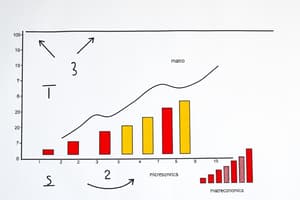Podcast
Questions and Answers
In microeconomics, the price of goods or services is determined by:
In microeconomics, the price of goods or services is determined by:
- The demand from consumers
- The government legislation
- The international market trends
- The cost of the resources used during production (correct)
Which of the following is NOT a key aspect of microeconomics?
Which of the following is NOT a key aspect of microeconomics?
- Labor Economics
- Supply and Demand
- Cost of Production
- International Market Analysis (correct)
What does labor economics in microeconomics primarily focus on?
What does labor economics in microeconomics primarily focus on?
- The impact of labor unions on wages
- Government regulations on labor practices
- The international labor market
- Patterns of wages, employment, and income (correct)
Which branch of economics takes a bottom-up approach to analyzing the economy?
Which branch of economics takes a bottom-up approach to analyzing the economy?
Macroeconomics primarily focuses on which level of economic analysis?
Macroeconomics primarily focuses on which level of economic analysis?
Which aspect is NOT typically covered in macroeconomics?
Which aspect is NOT typically covered in macroeconomics?
What is the primary focus of macroeconomics?
What is the primary focus of macroeconomics?
How does macroeconomics differ from microeconomics?
How does macroeconomics differ from microeconomics?
What does Gross Domestic Product (GDP) provide a snapshot of?
What does Gross Domestic Product (GDP) provide a snapshot of?
Why is understanding inflation crucial in macroeconomics?
Why is understanding inflation crucial in macroeconomics?
What does the unemployment principle in macroeconomics provide insights into?
What does the unemployment principle in macroeconomics provide insights into?
How do microeconomic principles contribute to understanding macroeconomic concepts?
How do microeconomic principles contribute to understanding macroeconomic concepts?
Why are microeconomics and macroeconomics considered interdependent?
Why are microeconomics and macroeconomics considered interdependent?
Why are microeconomics and macroeconomics essential subtopics within economics?
Why are microeconomics and macroeconomics essential subtopics within economics?
What does macroeconomics seek to explain?
What does macroeconomics seek to explain?
How do economists gain valuable insights into the complex interactions that shape the economy?
How do economists gain valuable insights into the complex interactions that shape the economy?
Study Notes
Economic Dynamics: Microeconomics and Macroeconomics
Economics is a multifaceted field that encompasses various subtopics, including microeconomics and macroeconomics. These two branches of economics are interdependent and complement one another, providing a comprehensive understanding of the economy.
Microeconomics
Microeconomics is the study of individuals' and businesses' decisions regarding the allocation of resources and prices at which they trade goods and services. It focuses on supply and demand, taxes, regulations, and government legislation. Some key aspects of microeconomics include:
- Cost of Production: According to this theory, the price of goods or services is determined by the cost of the resources used during production.
- Labor Economics: This principle looks at workers and employers, trying to understand patterns of wages, employment, and income.
Microeconomics takes a bottom-up approach to analyzing the economy, focusing on human choices, decisions, and the allocation of resources. However, it does not attempt to answer or explain what forces should take place in a market.
Macroeconomics
Macroeconomics is the study of national and government decisions, focusing on the bigger picture of the economy. It often extends to the international sphere because domestic markets are linked to investment and capital flows. Some key aspects of macroeconomics include:
- Gross Domestic Product (GDP): This is the total value of goods and services produced by a country over a specific period, providing a snapshot of the country's economic health.
- Inflation: Macroeconomics examines the rate at which prices rise, which is crucial for understanding the overall level of demand and the effectiveness of government policies.
- Unemployment: This principle looks at the percentage of people in a country who are unable to find work, providing insights into the labor market and the effectiveness of government policies.
Macroeconomics adopts a top-down approach, focusing on the broader economic environment and the decisions made by countries and governments. It seeks to explain the big picture, offering insights into the forces that drive market behavior and the impact of economic policies on the overall economy.
The Intersection of Microeconomics and Macroeconomics
While microeconomics and macroeconomics may seem distinct, they are interdependent and influence each other. For instance, microeconomic principles, such as supply and demand, can help explain macroeconomic concepts, like GDP and inflation. By combining microeconomic and macroeconomic perspectives, economists can gain a more comprehensive understanding of the economy and develop more effective policies to address various economic challenges.
In conclusion, microeconomics and macroeconomics are two essential subtopics within the field of economics, providing a robust framework for understanding the dynamics of the economy. By examining the interplay between individual decisions and national policies, economists can gain valuable insights into the complex interactions that shape the economy and inform the development of effective economic policies.
Studying That Suits You
Use AI to generate personalized quizzes and flashcards to suit your learning preferences.
Description
Explore the interdependent realms of microeconomics and macroeconomics, their key principles, and their impact on the economy. Understand the bottom-up analysis of individual choices in microeconomics and the top-down perspective of national decisions in macroeconomics, and how they collectively shape economic policies.




